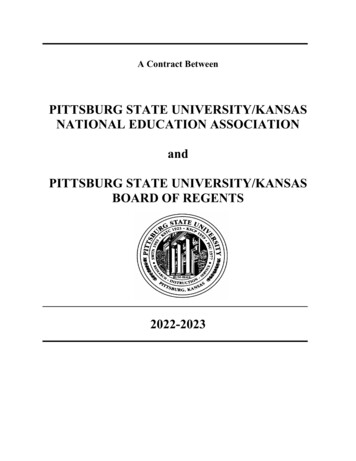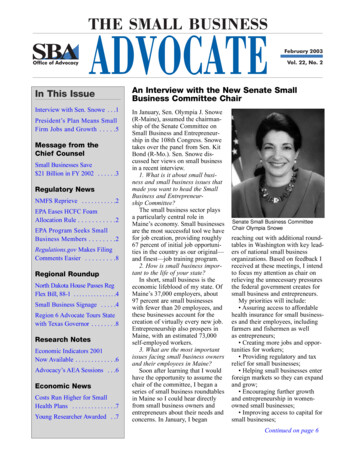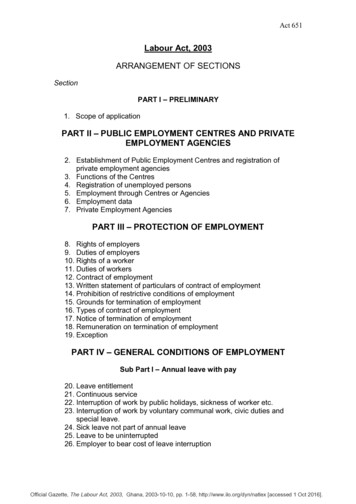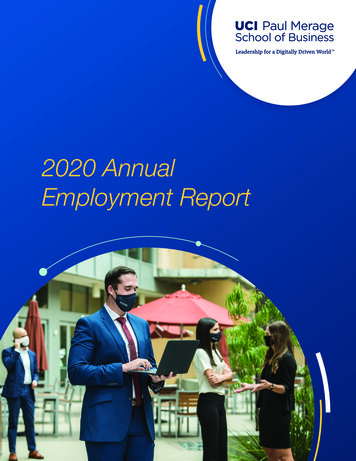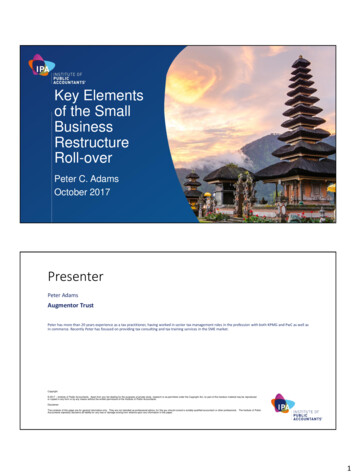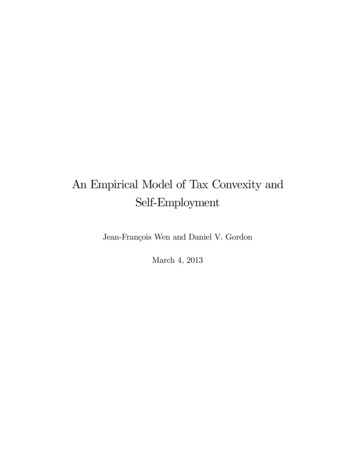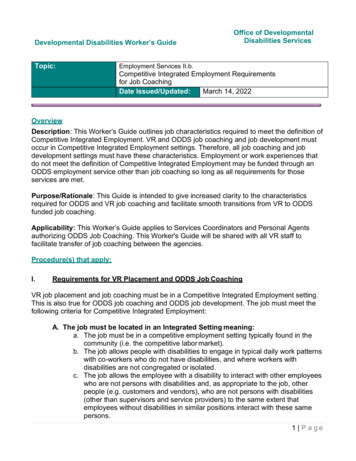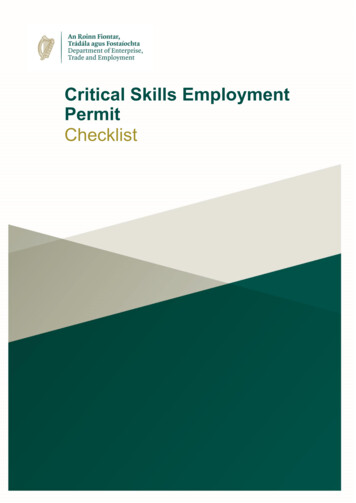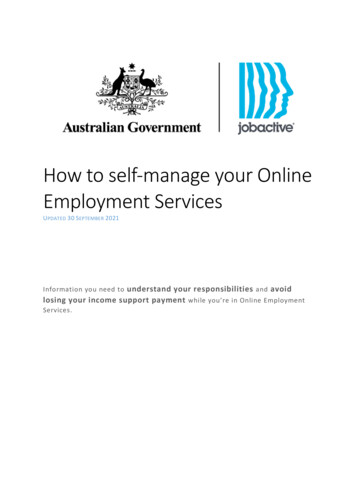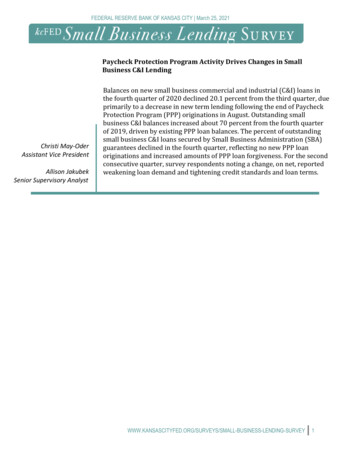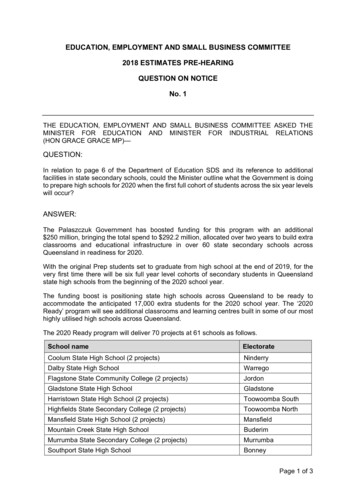
Transcription
EDUCATION, EMPLOYMENT AND SMALL BUSINESS COMMITTEE2018 ESTIMATES PRE-HEARINGQUESTION ON NOTICENo. 1THE EDUCATION, EMPLOYMENT AND SMALL BUSINESS COMMITTEE ASKED THEMINISTER FOR EDUCATION AND MINISTER FOR INDUSTRIAL RELATIONS(HON GRACE GRACE MP)—QUESTION:In relation to page 6 of the Department of Education SDS and its reference to additionalfacilities in state secondary schools, could the Minister outline what the Government is doingto prepare high schools for 2020 when the first full cohort of students across the six year levelswill occur?ANSWER:The Palaszczuk Government has boosted funding for this program with an additional 250 million, bringing the total spend to 292.2 million, allocated over two years to build extraclassrooms and educational infrastructure in over 60 state secondary schools acrossQueensland in readiness for 2020.With the original Prep students set to graduate from high school at the end of 2019, for thevery first time there will be six full year level cohorts of secondary students in Queenslandstate high schools from the beginning of the 2020 school year.The funding boost is positioning state high schools across Queensland to be ready toaccommodate the anticipated 17,000 extra students for the 2020 school year. The ‘2020Ready’ program will see additional classrooms and learning centres built in some of our mosthighly utilised high schools across Queensland.The 2020 Ready program will deliver 70 projects at 61 schools as follows.School nameElectorateCoolum State High School (2 projects)NinderryDalby State High SchoolWarregoFlagstone State Community College (2 projects)JordonGladstone State High SchoolGladstoneHarristown State High School (2 projects)Toowoomba SouthHighfields State Secondary College (2 projects)Toowoomba NorthMansfield State High School (2 projects)MansfieldMountain Creek State High SchoolBuderimMurrumba State Secondary College (2 projects)MurrumbaSouthport State High SchoolBonneyPage 1 of 3
School nameElectorateBremer State High SchoolIpswichBrisbane State High SchoolSouth BrisbaneCairns State High SchoolCairnsHelensvale State High SchoolTheodoreIpswich State High SchoolIpswich WestKelvin Grove State CollegeMcConnelMackay Northern Beaches State High SchoolWhitsundayMeridan State CollegeKawanaNorth Lakes State CollegeBancroftOrmeau Woods State High SchoolCoomeraPimpama State Secondary CollegeCoomeraSpringfield Central State High SchoolJordanThe Gap State High SchoolCooperVarsity CollegeMermaid BeachWynnum State High SchoolLyttonAlbany Creek State High SchoolEvertonAlexandra Hills State High SchoolCapalabaBeenleigh State High SchoolMacalisterBribie Island State High SchoolPumicestoneCaboolture State High SchoolMorayfieldCavendish Road State High SchoolGreenslopesCentenary Heights State High SchoolToowoomba SouthCentenary State High SchoolMount OmmaneyChancellor State CollegeBuderimCleveland District State High SchoolOodgerooFerny Grove State High SchoolFerny GroveForest Lake State High SchoolInalaGlenala State High SchoolInalaIndooroopilly State High SchoolMaiwarJames Nash State High SchoolGympieKawana Waters State CollegeKawanaKedron State High SchoolClayfieldLaidley State High SchoolLockyerLowood State High SchoolLockyerMansfield State High SchoolMansfieldMaroochydore State High SchoolMaroochydoreMarsden State High SchoolWaterfordMount Gravatt State High SchoolGreenslopesMountain Creek State High SchoolBuderimPage 2 of 3
School nameElectorateNorthern Beaches State High SchoolHinchinbrookPacific Pines State High SchoolGavenPalm Beach-Currumbin State High SchoolBurleighPark Ridge State High SchoolLoganPimlico State High SchoolTownsvilleProserpine State High SchoolWhitsundayRochedale State High SchoolMansfieldSouthport State High SchoolBonneyStretton State CollegeStrettonSunshine Beach State High SchoolNoosaTamborine Mountain State High SchoolScenic RimToolooa State High SchoolGladstoneTrinity Bay State High SchoolCairnsWindaroo Valley State High SchoolMacalisterYeppoon State High SchoolKeppelPage 3 of 3
EDUCATION, EMPLOYMENT AND SMALL BUSINESS COMMITTEE2018 ESTIMATES PRE-HEARINGQUESTION ON NOTICENo. 2THE EDUCATION, EMPLOYMENT AND SMALL BUSINESS COMMITTEE ASKED THEMINISTER FOR EDUCATION AND MINISTER FOR INDUSTRIAL RELATIONS(HON GRACE GRACE MP)—QUESTION:In relation to page 6 of the Department of Education SDS and its reference to the 235 millionfour-year Renewing our Schools program, could the Minister provide an update on progressfor the 17 schools which will be enhanced and upgraded under this program?ANSWER:The Palaszczuk Government committed to investing 235 million over four years from2018–19 in the Renewing our Schools program.The program will deliver school infrastructure upgrades and refurbishments to 17 schools,focused on improving school learning facilities.In Term 2, 2018, planning work commenced for the program, which includes school visits,discussions with school principals regarding the potential scope of works, and thecommencement of some initial concept planning work.The 17 schools funded under the program are listed below:School nameAspley State High SchoolBundaberg State High SchoolCairns State High SchoolCorinda State High SchoolEverton Park State High SchoolFerny Grove State High SchoolHeatley Secondary CollegeIndooroopilly State High SchoolMansfield State High SchoolMaryborough State High SchoolMitchelton State High SchoolProserpine State High SchoolSarina State High SchoolSpringwood State High SchoolToowoomba State High SchoolTropical North Learning Academy – Trinity Beach State SchoolTropical North Learning Academy – Smithfield State High SchoolElectorateAspleyBundabergCairnsMount OmmaneyEvertonFerny GroveThuringowaMaiwarMansfieldMaryboroughFerny GroveWhitsundayMiraniSpringwoodToowoomba NorthBarron RiverBarron River
EDUCATION, EMPLOYMENT AND SMALL BUSINESS COMMITTEE2018 ESTIMATES PRE-HEARINGQUESTION ON NOTICENo. 3THE EDUCATION, EMPLOYMENT AND SMALL BUSINESS COMMITTEE ASKEDTHE MINISTER FOR EDUCATION AND MINISTER FOR INDUSTRIAL RELATIONS(HON GRACE GRACE MP)—QUESTION:In relation to page 6 of the Department of Education SDS and its reference to the Governmentemploying more than 1,000 teachers as part of a four-year commitment, can the Ministeradvise how many additional teachers and teacher aides are being employed in Queenslandstate schools in the 2018 school year?ANSWER:The Palaszczuk Government is committed to a world class education for every child andsupporting quality teachers in every school. Over the next four years the Government hascommitted 1 billion from existing funding to employ an additional 3700 extra teachers.In 2018–19, the Department of Education will employ an additional 1000 teachers as part ofthis commitment to employ the additional teachers required to support enrolment growthacross the state.As at Quarter 1, 2018 the state school teaching workforce has grown by 1354.27 full-timeequivalent (FTE) teachers over Quarter 1 2017, including the final tranche of 295 teacherFTEs under the Palaszczuk Government’s 875 Extra Teachers initiative. Every state primary,secondary, combined and special school benefited through the allocation of these additionalteacher numbers.In addition to teacher growth, for the same period the teacher aide workforce has grown by320.36 teacher aide FTEs, including the additional 4000 hours per week allocated under theGovernment’s commitment to support full-time teacher aides for Prep classes in state schools.
EDUCATION, EMPLOYMENT AND SMALL BUSINESS COMMITTEE2018 ESTIMATES PRE-HEARINGQUESTION ON NOTICENo. 4THE EDUCATION, EMPLOYMENT AND SMALL BUSINESS COMMITTEE ASKED THEMINISTER FOR EDUCATION AND MINISTER FOR INDUSTRIAL RELATIONS(HON GRACE GRACE MP)—QUESTION:In relation to page 6 of the Department of Education SDS and its reference to theGovernment investing 14.4 m over four years to employ additional instrumental musicteachers, can the Minister advise how this money will raise the profile of instrumental musicacross the state?ANSWER:The Palaszczuk Government is committed to creating a world class education forQueensland students. A total of 14.4 million will be invested over four years for: an additional 45 full-time equivalent (FTE) instrumental music teachers/instructors; 1 million for additional musical instruments for schools; and flow-on funding to non-state schools as part of the basket-nexus funding arrangements.Employing additional instrumental music teachers/instructors and providing musicalinstruments will engage more students in the Arts, especially students in regional andremote areas.More students participating in the Queensland Instrumental Music Program will raise theprofile of instrumental music across the state.The number of FTE instrumental music teachers/instructors in state schools will increasefrom 335.1 to 380.1 over three school years from 2019. This will provide access to theprogram for a greater number of students in all regions.The Queensland Instrumental Music Program was initiated in primary and secondaryschools in 1971 and has since continued to expand and develop across Queensland.The program provides comprehensive tuition in which students learn orchestral or bandinstruments in small groups and larger ensembles.
EDUCATION, EMPLOYMENT AND SMALL BUSINESS COMMITTEE2018 ESTIMATES PRE-HEARINGQUESTION ON NOTICENo. 5THE EDUCATION, EMPLOYMENT AND SMALL BUSINESS COMMITTEE ASKEDMINISTER FOR EDUCATION AND MINISTER FOR INDUSTRIAL RELATIONS(HON GRACE GRACE MP) —QUESTION:In relation to page 6 of the Department of Education SDS, can the Minister advise on how theReady Reading Program will support greater literacy engagement for Queensland students?ANSWER:The Queensland Government wants all young Queenslanders to value reading and gain thelifelong benefits of being effective readers.Students’ engagement in frequent shared reading activities, with positive adult support, canhave long-lasting benefits for later school success.We also know that research on parent involvement in their children’s reading skills suggestsclear links from home reading experiences, through early literacy skills, to fluent reading.That is why the Palaszczuk Government will be investing 1.6 million over three years in theQueensland Ready Reading (QRR) volunteer program, as part of our plan to improve literacyand numeracy for every child, including a focus on Closing the Gap on Year 3 reading.The QRR is designed to enhance current classroom reading programs, which will providechildren with additional positive reading experiences, enabling them to engage in reading moreregularly.Up to 3000 parents, caregivers and community members will be trained by experienced staffat the Reading Centre (within the Department of Education) as Ready Reading volunteers inschools to build their confidence in supporting children’s engagement in reading.A major benefit of the QRR program is that every parent, caregiver and community membertrained will be a potential volunteer to support reading engagement in local schools.The QRR program has the capacity to increase frequency of book reading in the communityand will also improve the percentage of babies and young children being read to at home asa foundation for engagement in reading and later literacy success.
EDUCATION, EMPLOYMENT AND SMALL BUSINESS COMMITTEE2018 ESTIMATES PRE-HEARINGQUESTION ON NOTICENo. 6THE EDUCATION, EMPLOYMENT AND SMALL BUSINESS COMMITTEE ASKED THEMINISTER FOR EDUCATION AND MINISTER FOR INDUSTRIAL RELATIONS(HON GRACE GRACE MP)—QUESTION:In relation to page 3 of the Department of Education SDS and its reference to delivering qualityearly years education and care, can the Minister advise on measures the Government is takingto support a highly skilled and capable early childhood workforce?ANSWER:The Palaszczuk Government is committed to supporting our workforce of highly skilled andcapable early childhood teachers and educators to give all Queensland children a great startin life.A highly skilled and professional workforce is essential to achieve the best outcomes forchildren. I acknowledge the important role early childhood education and care staff undertakeeach and every day working with children and families to make a difference in the critical earlyyears.The Queensland Government is continuing to implement the Early Childhood Education andCare Workforce Action Plan 2016–19 (ECEC WAP) to support a professional, qualified andskilled early childhood workforce in Queensland, backed by a joint Queensland Governmentinvestment of up to 80 million between the Department of Employment, Small Business andTraining and the Department of Education.The key initiatives delivered under the ECEC WAP since 2016 include: the Certificate III Guarantee and Higher Level Skills Programs, providing over 19,000subsidies to support existing and aspiring educators to gain Diploma and Certificate IIIearly childhood qualifications; the Early Childhood Bridging Teacher Program providing subsidies which have supported125 eligible primary teachers to fast track their career and gain approved early childhoodteaching qualifications; an Early Childhood Teaching Scholarship Program for up to 40 rural and remoteeducators to address workforce shortages; study support programs through the Indigenous Remote Support Coordination andGrowing Our Own Program for more than 240 rural and remote early childhood educators; age-appropriate pedagogies supporting primary school teachers to enhance theirteaching approaches and practice in the early years; and expanding the Remote Area Teacher Education Program in six remote communities toenable 58 Aboriginal and Torres Strait Islander educators to undertake early childhoodqualifications in their home communities.In partnership with the early childhood sector, the Palaszczuk Government is helping to buildan early childhood workforce that has the qualifications, skills and support to provide the verybest services for all Queensland children and families.
EDUCATION, EMPLOYMENT AND SMALL BUSINESS COMMITTEE2018 ESTIMATES PRE-HEARINGQUESTION ON NOTICENo. 7THE EDUCATION, EMPLOYMENT AND SMALL BUSINESS COMMITTEE ASKED THEMINISTER FOR EDUCATION AND MINISTER FOR INDUSTRIAL RELATIONS(HON GRACE GRACE MP)—QUESTION:In relation to page 10 of the Department of Education SDS and its reference to thefive-yearly review of the operation of the workers’ compensation scheme under the Workers’Compensation and Rehabilitation Act 2003, can the Minister outline the key recommendationsmade by the independent reviewer in relation to the scheme?ANSWER:The terms of reference for the review were focused on ensuring the workers’ compensationscheme is well placed to respond to emerging issues.The review found the scheme is performing well, is financially sound, involves low costs foremployers and provides fair treatment for both employers and injured workers.Major scheme reform is not recommended; however, a number of opportunities were identifiedto improve the process and experience for injured workers.The report made 57 recommendations, with key recommendations focusing on: protecting vulnerable workers employed within the rapidly expanding gig economy toensure they are not unreasonably denied access to workers’ compensation benefits andthat a consistent approach is adopted for persons working in the gig economy; supporting workers with a psychological or psychiatric injury by providing early interventionin order to minimise the severity, duration and recurrence of psychological illness andtaking a best practice approach to the management of these complex claims; improving return to work outcomes by extending obligations to provide access to anaccredited return to work program to workers at the end of their statutory claim if they arefit for work but have no job to return to and providing greater support to rehabilitation andreturn to work coordinators at the workplace level; and providing greater assistance to small business through funding allied health professionalsto undertake onsite job task assessments to assist those businesses having difficulty inreturning an injured worker to work.The Queensland Government will consider these recommendations in the second half of 2018.As part of this process stakeholders will be consulted.
EDUCATION, EMPLOYMENT AND SMALL BUSINESS COMMITTEE2018 ESTIMATES PRE-HEARINGQUESTION ON NOTICENo. 8THE EDUCATION, EMPLOYMENT AND SMALL BUSINESS COMMITTEE ASKED THEMINISTER FOR EDUCATION AND MINISTER FOR INDUSTRIAL RELATIONS(HON GRACE GRACE MP)—QUESTION:In relation to page 10 of the Department of Education SDS and its reference to overseeing theongoing delivery of the legislative reforms and regulatory improvements to Queensland’sindustrial relations workplace health and safety and electrical safety systems, can the Ministeradvise what initiatives have been put in place to explore any required legislative and regulatorychanges concerning the new and emerging solar and wind farm industry in Queensland?ANSWER:The use of renewable energies, such as solar and wind, are growing at a rapid rate.A significant number of large scale solar and wind farms are expected to be constructed inQueensland over the next decade.A tripartite working group has been established to develop codes of practice and identify anyassociated regulatory changes required for the design, construction, commissioning,operation and maintenance of solar and wind farms.Given the rapid growth of solar farms in Queensland and the safety and electrical risksassociated with these farms, the Palaszczuk Government is prioritising the development ofthe solar farm code of practice.The draft solar farm code of practice was released last week to the working group for theirconsideration and input.The solar farm code of practice is expected to be finalised by the end of 2018.Following finalisation of the solar farm code of practice, a similar process will be undertakenfor wind farms.I have also asked the Office of Industrial Relations to work closely with the Electrical SafetyCommissioner and the Electrical Safety Board on the development of the codes of practiceand regulatory changes.
EDUCATION, EMPLOYMENT AND SMALL BUSINESS COMMITTEE2018 ESTIMATES PRE-HEARINGQUESTION ON NOTICENo. 9THE EDUCATION, EMPLOYMENT AND SMALL BUSINESS COMMITTEE ASKED THEMINISTER FOR EDUCATION AND MINISTER FOR INDUSTRIAL RELATIONS(HON GRACE GRACE MP)—QUESTION:In relation to page 10 of the Department of Education SDS and its reference to theimplementation of the Best Practice Review of Workplace Health and Safety Queensland FinalReport 2017, can the Minister advise on the status of the implementation of therecommendations contained within the report?ANSWER:The Best Practice Review of Workplace Health and Safety Queensland (the Best PracticeReview), which was led by Mr Tim Lyons and supported by a tripartite reference group, wasundertaken in response to the tragic fatalities at Dreamworld and an Eagle Farm constructionsite in 2016.The Best Practice Review final report was provided to the Queensland Government inJuly 2017, making 58 recommendations, with the majority relating to operationalimprovements for either Workplace Health and Safety Queensland (WHSQ) or the WorkHealth and Safety (WHS) Board.Over 90% of the Best Practice Review recommendations are either fully implemented or welladvanced. The WHS Board is monitoring the implementation of the recommendations and willcontinue to do so until completion.Legislative amendments to work health and safety legislation were passed by the QueenslandParliament in October 2017, including: the introduction of a new offence of industrial manslaughter; the establishment of an independent statutory office for work health and safetyprosecutions; the restoration of the status of codes of practice to require safety measures in codes tobe followed unless measures of an equal or higher standard can be demonstrated; and provisions which support more effective health and safety representatives.The Palaszczuk Government is also in the process of developing regulatory amendments toimprove safety in theme parks and the amusement ride industry.A large number of Best Practice Review recommendations designed to re-position WHSQcapability to more effectively regulate workplaces, have either been implemented, or are welladvanced. The structural separation of the inspectorate and investigations functions, awayfrom the corporate service, capacity building and engagement work of WHSQ, has been fullyimplemented and a new Executive Director, WHS Compliance and Field Services, has beenappointed.
Recruitment and appointment processes for an independent WHS prosecutor are welladvanced and the establishment of the independent Office of the WHS prosecutor will followthis appointment.In order to support the improvements already implemented, the WHS Board is in the finalstages of developing its Five-Year Strategic Plan for WHS in Queensland.Other recommendations require longer-term development, planning and resource allocation,for example, the consolidation and upgrading of regulatory databases requiring thedevelopment and implementation of a new information and communication and technologysystem, are still in progress. Likewise, the skills development program for WHSQ inspectorsis an incremental process which requires sustained focus over several years, as well asongoing maintenance.
EDUCATION, EMPLOYMENT AND SMALL BUSINESS COMMITTEE2018 ESTIMATES PRE-HEARINGQUESTION ON NOTICENo. 10THE EDUCATION, EMPLOYMENT AND SMALL BUSINESS COMMITTEE ASKED THEMINISTER FOR EDUCATION AND MINISTER FOR INDUSTRIAL RELATIONS(HON GRACE GRACE MP)—QUESTION:In relation to page 10 of the Department of Education SDS and its reference to supporting fairand productive workplaces, can the Minister outline submissions the Government has madein support of low paid Queensland workers?ANSWER:The Palaszczuk Government will always advocate on behalf of Queensland’s low paidworkers, whether they are covered by the state industrial relations jurisdiction or the nationalworkplace relations system. This commitment has been demonstrated by the varioussubmissions the Queensland Government has made in support of weekend penalty rates forlow-paid workers who miss out on time with friends and family as they try to make ends meet.This commitment is also evident in submissions made by the Queensland Government to theSenate Inquiry into the Future of Work and Workers, and the Annual Wage Review (AWR). Inboth submissions particular regard was given to the protection of Queensland’s low paidworkers.On 27 February 2018, the Queensland Government made a submission to the Senate Inquiryinto the Future of Work and Workers where protection of vulnerable workers was identified asa matter of priority. In particular, the Queensland Government called for reform of theFair Work Act 2009 and other relevant legislation to more adequately accommodate emergingforms of non-traditional employment, including engagement within the gig economy, to ensurethat the national workplace relations system protects vulnerable workers and remains fair andequitable for all working Australians.In March 2018, the Queensland Government submission to the Fair Work Commission AWRadvocated for an increase of 27.10 per week in the national minimum wage (NMW)(equivalent to a 3.9% increase) and a fair and reasonable increase to all other award rates ofpay.In support of its claim, Queensland’s submission argued that minimum and award wageincreases directly target and benefit those employees who are unable to negotiate wageincreases through enterprise bargaining and that increases awarded through the AWR help toensure workers with little or no bargaining power are not left behind.On 1 June 2018, the Fair Work Commission handed down an increase of 3.5% to the NMWand award rates of pay in the AWR. In dollar terms, this means an increase of 24.32 a week,lifting the national minimum wage to 719.22 a week or 18.29 an hour. This will provide amuch-need real wage increase for almost half a million low-paid private sector workers inQueensland.
EDUCATION, EMPLOYMENT AND SMALL BUSINESS COMMITTEE2018 ESTIMATES PRE-HEARINGQUESTION ON NOTICENo. 11THE EDUCATION, EMPLOYMENT AND SMALL BUSINESS COMMITTEE ASKED THEMINISTER FOR EDUCATION AND MINISTER FOR INDUSTRIAL RELATIONS(HON GRACE GRACE MP)—QUESTIONWith reference to page 17 of the SDS regarding the Departmental budget summary andQuestion on Notice 197 asked on 8 March 2018, can the Minister provide an update on fundingallocations for the State Government’s Chaplaincy/Student Welfare Program for 2018/19 and2019/20, reported separately by year, given the Australian Government has just recentlyannounced a four-year funding extension to the National School Chaplaincy Programme?ANSWER:On 25 July 2018, Senator the Honourable Simon Birmingham, Minister for Education andTraining, advised Queensland of its proposed renewal of the Australian Government’sNational School Chaplaincy Programme from 2018–19 to 2021–22.Indicative Australian Government funding for Queensland under this over four years is 73.4 million, consisting of 18.35 million each year from 2018–19 to 2021–22.The Queensland Government is working with the Australian Government to finalise a newproject agreement by early October 2018 to allow continuation of the program.The final details of the funding arrangements will not be known until negotiations with theAustralian Government are completed later this year.The Palaszczuk Government has allocated 12.66 million in additional chaplaincy and studentwelfare worker funding to address the shortfall in the Australian Government’s NationalSchool Chaplaincy Programme funding across 2015–18 to ensure that schools can maintainlevels of service.In addition, under the State Government Chaplaincy/Student Welfare Funding Program thathas been in place since 2007, annual funding of 1.129 million will be provided to 147 stateschools over the 2018–19 and 2019–20 financial years.
EDUCATION, EMPLOYMENT AND SMALL BUSINESS COMMITTEE2018 ESTIMATES PRE-HEARINGQUESTION ON NOTICENo. 12THE EDUCATION, EMPLOYMENT AND SMALL BUSINESS COMMITTEE ASKED THEMINISTER FOR EDUCATION AND MINISTER FOR INDUSTRIAL RELATIONS(HON GRACE GRACE MP)—QUESTION:With reference to page 21 of the SDS regarding staffing, can the Minister provide a genderbreakdown of primary school teachers employed by Education Queensland as at 30 June2018 and also the total number of new primary school teachers employed by EducationQueensland in 2017/18, reported separately by gender?ANSWER:As at Quarter 1 2018, the Department of Education employed 26,904 teachers in primaryschools with the gender breakdown shown in the table below:MaleFemale3,94622,958During the 2017–18 financial year, the department appointed 3,562 primary school teachers,including both graduate and experienced teachers, the below table indicates the genderbreakdown:MaleFemale4923,070
EDUCATION, EMPLOYMENT AND SMALL BUSINESS COMMITTEE2018 ESTIMATES PRE-HEARINGQUESTION ON NOTICENo. 13THE EDUCATION, EMPLOYMENT AND SMALL BUSINESS COMMITTEE ASKEDMINISTER FOR EDUCATION AND MINISTER FOR INDUSTRIAL RELATIONS(HON GRACE GRACE MP)—QUESTION:With reference to page 6 of the SDS regarding Prep as part of School Education, can theMinister outline:a)the number of day 8 prep enrolments (reported separately by region) for 2018;b)the forecast prep enrolments (reported separately by region) that were expected for2018;c)whether any audits have been undertaken in relation to the age students attendingPrep in 2018; andd)in relation to c) above, the results of those audits and the number of students who wereattending Prep in 2018 that have had to cancel their enrolment?ANSWER:The table below outlines the forecast and actual headcount for Prep enrolments separatedby region:2018 State School prep year enrolments by regionCentral QueenslandDarling Downs South WestFar North QueenslandMetropolitanNorth CoastNorth QueenslandSouth East QueenslandQueensland e: Actual enrolment data – Department of Education, Queensland Government. February Corporate EnrolmentCollection, 2018.Forecast enrolment data – Queensland Government Statistician’s Office, Queensland Government. Enrolment Forecasts, 2017Edition.Note – Day 8 enrolment data is based on Full-Time Equivalent Counts (FTE) and not headcount. For comparative purposeswith QGSO forecast headcount data, February enrolment headcount data has been used in the table above.Data excludes special schools and schools of distance education.
2The Department of Education collects and analyses data annually on the age of studentswho are enrolled in Prep in state schools to ensure that legislative requirements regardingPrep eligibility are met. Where there are inconsistencies in the enrolment data, thedepartment seeks advice from the relevant schools.The analysis identified four students who were incorrectly enrolled.Changes to OneSchool, the department’s information technology system, are beingprogressed to provide additional safeguards so that if all eligibility criteria are not met, thedetails will not save in OneSchool and the enrolment process will end.
EDUCATION, EMPLOYMENT AND SMALL BUSINESS COMMITTEE2018 ESTIMATES PRE-HEARINGQUESTION ON NOTICENo. 14THE EDUCATION, EMPLOYMENT AND SMALL BUSINESS COMMITTEE ASKED THEMINISTER FOR EDUCATION AND MINISTER FOR INDUSTRIAL RELATIONS(HON GRACE GRACE MP)—QUESTION:With reference to page 20 of the SDS regarding the Capital budget and land purchases, canthe Minister outline whether any acquisitions were required as part of land purchases for theplanning of new schools in 2017/18 or 2018/19 and the budget for any acquisitions required(reported separately per school)?ANSWER:New schools are planned over multiple years and land acquisition occurs as part of theinvestment plan
The Palaszczuk Government has boosted funding for this program with an additional 250 million, bringing the total spend to 292.2 million, allocated over two years to build extra . Ipswich State High School Ipswich West Kelvin Grove State College McConnel Mackay Northern Beaches State High School Whitsunday . Alexandra Hills State High .
